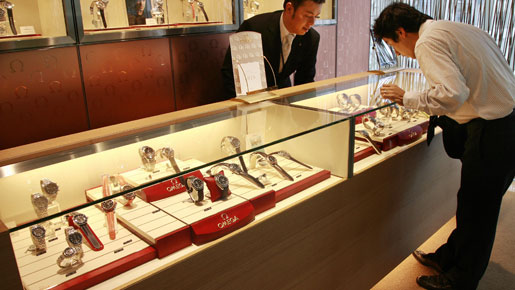
At the end of 2004, Swiss watchmaking exports passed the 11 billion Swiss francs mark for the first time. In 2005, the 12 billion franc barrier was broken and this was followed by 13 billion francs at the end of 2006. Our branch is benefiting fully from the strength of the world markets and consumer sentiment which remains fairly good overall. All the main traditional markets for Swiss watch products, USA, Hong Kong, Japan, Italy, Germany and France, are growing although to different degrees. Progress on the emerging markets, such as China, Mexico, Turkey, Ukraine and India, is particularly pleasing. It is important for our branch to be present all over the world. This global presence enables the risks arising from local recessions to be spread more widely.
Of course, to benefit from this good economic situation, consumers must be offered attractive products of good quality. The Swiss brands are constantly investing in new technologies and new designs. The collections are being regularly renewed, adjusted or supplemented. Colours are becoming bolder and Swiss watchmakers are trying out all kinds of materials. Titanium cases have made their appearance, mother-of-pearl is being used more widely on dials – even the movements of mechanical watches are being made from new materials. Silicone and even diamonds are being used for some strategic components such as the escapement; these materials have all the properties needed to handle the technical stresses encountered. The new materials can of course help to improve product quality and dependability, for instance by reducing friction.
The positive trend of the Swiss watch industry is remarkable in the mechanical domain. Technically, watches with mechanical movements are attracting growing attention. It is true that mechanical watches account for just 14 percent of volume, but at the same time they generate 65 percent in value. Growth of Swiss global watch exports is likely to be up 10 percent in value terms at the end of 2006. This growth is accounted for in large measures by watches at the higher end of the price scale.
Competition naturally exists between watch manufacturers, but watches are also having to compete with other products because there are nowadays thousands of different ways of spending your money on products (mobile phones, clothing, cars) or services (travel). Nevertheless we are confident in the future of Swiss watches which must not be regarded solely as a functional object that tells the time. More in the nature of a jewel than of an impersonal accessory, they elicit an emotional response. They help to shape the identity of the wearer. Watches are a cult object and a dream that can come true. Consumers therefore wish to wear watches to assert their personality. Unlike telephones, watches are not discarded. They are kept. And so watches are certainly not set to disappear as long as men and women wish to experience real emotions.
The future is looking bright. Surveys of the manufacturers show that new orders taken are rising and production also increasing. We expect growth to continue therefore in 2007 on the same scale as in recent years and we believe that Swiss watch exports might once again rise by 9-10 percent. Of course, these forecasts are liable to be affected by events beyond our control, such as a sharp fall in the value of the US dollar against the Swiss franc or if destabilising geopolitical events occur.

